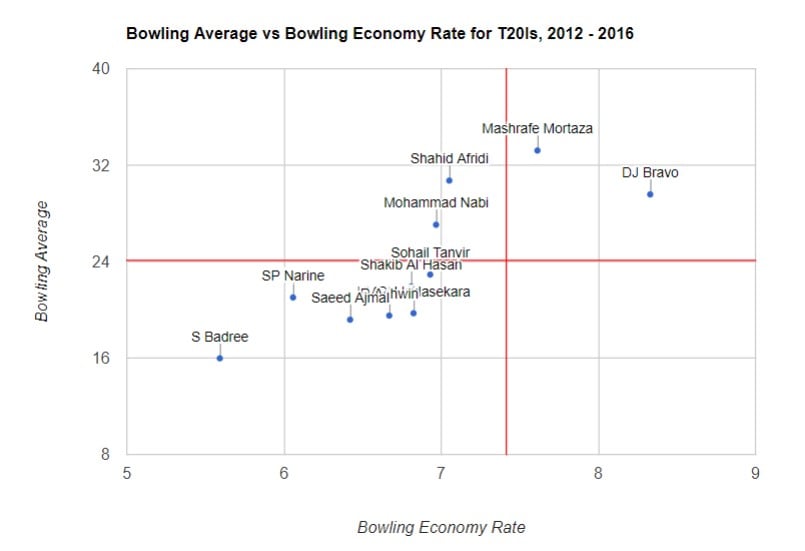Last Updated on 2 months by Charbel Coorey
Samuel Badree: The most overlooked T20 cricketer ever? | A look at the career and numbers of Samuel Badree. Is he the most overlooked T20 player?
Quality wrist-spin bowling is always a joy to watch. Although, at the same time, wrist-spin is inherently an extremely difficult craft to master. It takes a long time to reach maturity and get the ball to pitch where you want it to. The difficulty involved is primarily due to the fact that the ball has to exit the side/back of your hand before travelling through the air, consequently giving you lesser control since your arm is no longer behind the ball.
But then, there stood out a wrist-spin maestro, who over a sample of 4,125 balls recorded a mind-boggling economy-rate of just 6.02 – lesser than the likes of Narine & Vettori – in T20 cricket. In this article, let us all take a trip down the memory line and reminisce about one of the most overlooked T20 cricketers of all-time – Samuel Badree.
In T20 cricket, each and every ball delivered in the powerplay is an event. Batsmen, generally, try to attack so as to maximise the field restrictions and score as many runs as possible, hence making life difficult for bowlers.
Being different from a traditional leg-spin bowler, Badree normally used to bowl in the first six overs. “I think I have opened the bowling every single time for the West Indies.” said the man himself in an interview with ESPNCricinfo in 2017. The fact that he, being a wrist-spinner, used to open the bowling make his contributions far more appreciable and momentous.
For spinners – wrist-spinners in particular – the challenge of bowling the new-ball is relatively greater than seamers. The presence of lacquer makes it tough to grip the ball, consequently making the already difficult task of bowling leg-spin with control twice more challenging. Despite this, the precision with which Badree delivered in the powerplay was exemplary.
Since he choked runs such well, whenever Badree was taken off the attack, batsmen often used to overcompensate and provide breakthroughs to other bowlers.

Badree wasn’t a ‘mystery spinner’, and neither was he a big turner of the ball.
In fact, what Badree did was pretty repetitive. Like a machine, he kept bowling his fast leg-breaks at a line and length most batsmen found difficult to hit. Also, he bowled the occasional wrong’un, turning in to the right-hander. But Badree being an anti-thesis to the typical West Indies player, away from all the attention and reception, nobody took note of his performances. He thrived on that fact that nobody planned for him.
Samuel Badree was a crucial part of Windies’ successful campaigns in the World T20. In 2012 – in Sri Lanka – Badree had an economy-rate of 5.56 as he picked 4 wickets in 4 games. Come 2016 – in India – he played 6 matches, picked 9 wickets at a bowling average of 13.77 and recorded a staggering economy-rate of 5.39. In both the editions, Badree succeeded in choking runs better than anybody else from the Windies squad.
In 2016, in the semi-final against India, whilst Simmons, Russell & Charles took the honours for a thrilling run-chase, in a game in which 388 runs were scored, Badree, who bowled his four overs for just 26 runs – also picking up the wicket of Rohit Sharma – as ever, went unnoticed, as he quietly did his job with the ball. Even in the final versus England, because of Carlos Brathwaite’s heroics, Badree’s spell of 4-1-16-2 never gets talked about.
In fact, Badree, with his sublime performances presented a strong case to be awarded as the man of the tournament in 2016. But yes, Badree being Badree, was once again overlooked.
Between 2012 and 2016, playing for the West Indies, he picked up 42 wickets – fourth highest after Ashwin, Afridi and Shakib Al Hasan. His bowling-average and strike-rate read 15.98 and 17.14 respectively, while his economy-rate was unbelievable as always – 5.59.

Besides the two World T20s, Badree’s performances had helped his team – Trinidad & Tobago – to prevail in the Caribbean Premier League as many as four times – in 2011, 2012, 2013 and 2015.

As per ‘Impact Index’, although Narine triumphed over Badree in a number of areas, what made Badree the ‘highest impact T20 player’ was his performances in playoff matches.
“Badree played in twenty-one big matches in his career and produced a high impact performance in six of them, failed in just four and done reasonably well in the others. Narine has played twenty-two such matches, with high impact performances four times and eight failures. Malinga has played twenty-four, with four high impact performances and ten failures. So, this is where Badree sails over the others, even though he has not been the leading act sometimes.
In the end, Badree’s impact in big matches is 25 per cent higher than Narine’s and 78 per cent higher than Malinga’s.”
Sadly though, since Badree never really made a mark in the IPL, notwithstanding the volume of his performances, he always remained under the radar. These days, he’s a spin-bowling coach for an IPL franchisee, the Delhi Capitals.
Written by Sparsh Telang. Follow Sparsh on Twitter today

